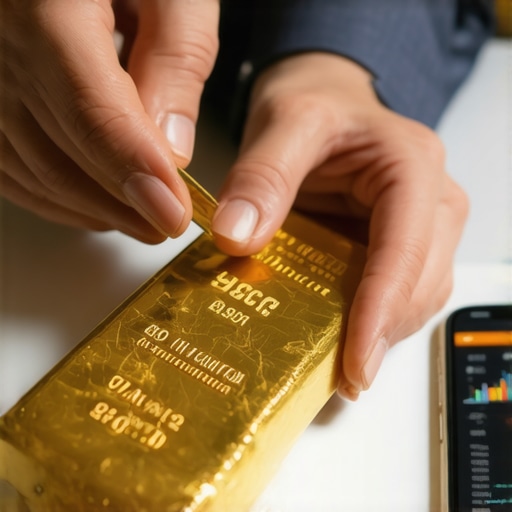Why Invest in Gold? Understanding the Appeal of Precious Metals
Investing in gold has long been regarded as a smart strategy for both seasoned investors and newcomers alike. As a tangible asset, gold offers a unique hedge against inflation and economic uncertainty. In times of market volatility, many turn to gold for its reliability and historical significance as a store of value. This guide aims to provide you with essential insights on how to start investing in gold, making it accessible even for beginners.
The Basics of Gold Investment: Types of Gold Assets
Before diving into the gold market, it’s crucial to understand the different types of gold investments available. Here are some common options:
Physical Gold: Coins and Bars
Purchasing physical gold, such as coins and bars, is one of the most traditional methods of investing. Gold coins are often favored by investors due to their liquidity and ease of storage. Popular choices include American Gold Eagles and Canadian Gold Maple Leafs. Bars, on the other hand, are typically available in larger quantities and can be more economical for serious investors. Familiarizing yourself with how to buy gold coins will enhance your purchasing experience.
Gold ETFs: A Convenient Alternative
For those preferring not to handle physical gold, gold exchange-traded funds (ETFs) offer a more convenient investment route. These funds track the price of gold and can be easily bought and sold on stock exchanges, making them an excellent option for investors looking to diversify their portfolios without the hassles of storage and security.
Gold Mining Stocks: Investing in Companies
Investing in gold mining stocks is another approach, allowing you to gain exposure to the gold market through companies that mine and sell gold. However, this method carries additional risks, as the performance of mining stocks can be influenced by factors such as management decisions and operational efficiency. A thorough understanding of evaluating gold stocks is essential for making informed investment decisions.
Steps to Start Investing in Gold
Now that you have a grasp of the various types of gold investments, here are essential steps to help you begin your journey:
1. Set Your Investment Goals
Before you invest, outline your objectives. Are you looking for short-term gains, or is gold a long-term investment for you? Understanding your goals will guide your investment choices.
2. Research and Educate Yourself
Dive deeper into the gold market by researching current trends. Resources like gold price trends can provide valuable insights into market movements, helping you make informed decisions.
3. Choose Your Investment Method
Based on your research and goals, select the investment method that aligns best with your strategy. Whether it’s physical gold, ETFs, or mining stocks, ensure it fits your risk tolerance and investment timeline.
4. Open an Account with a Reputable Dealer
If you’re purchasing physical gold, choose a reputable dealer with a solid track record. For ETFs or mining stocks, open an account with a trusted brokerage that offers access to the gold market.
By following these steps, you can confidently embark on your gold investment journey. Remember, investing in gold is not just about buying; it’s about understanding the market dynamics and making informed choices. Stay educated and engaged to maximize your investment potential!
Understanding Gold Market Dynamics: Key Factors Influencing Prices
To effectively invest in gold, it’s essential to grasp the factors that influence gold prices. Economic indicators, geopolitical tensions, and central bank policies play a pivotal role in shaping market dynamics. For instance, during periods of economic uncertainty, the demand for gold typically increases, driving prices higher. Investors should also be aware of how global supply and demand affect gold prices, as these can lead to significant fluctuations in value.
The Role of Central Banks in Gold Investment
Central banks are major players in the gold market, holding substantial reserves of gold as part of their monetary policy. Their buying and selling activities can create ripples in the gold market. Understanding how central bank purchases influence gold prices can provide insight into future price movements and help investors make strategic decisions.
Maximizing Returns: Smart Gold Trading Techniques
When investing in gold, employing effective trading techniques can significantly enhance your returns. Here are a few strategies to consider:
1. Timing Your Purchase
Timing your entry into the gold market is crucial. Keep an eye on gold price trends to identify optimal buying opportunities. Often, prices dip during certain market cycles, allowing savvy investors to acquire gold at a lower cost.
2. Diversifying Your Gold Portfolio
To mitigate risks associated with gold investments, diversifying your portfolio is essential. Consider a mix of physical gold, ETFs, and mining stocks. This strategy not only spreads risk but can also enhance potential returns. Explore the benefits of adding gold to your investment portfolio for a more balanced approach.
3. Staying Informed on Market Trends
Being informed is key to successful investing. Regularly review relevant market analyses and reports to stay ahead of trends. Resources that discuss top trends in the gold market can keep you updated on potential changes that may impact your investments.
Risks of Gold Investment: What You Should Know
Like any investment, gold carries risks that investors should be aware of. Price volatility can be influenced by several factors, including geopolitical events and economic shifts. Understanding the risks of gold trading can help you prepare for unexpected market changes and develop a resilient investment strategy.
Market Volatility and Economic Factors
The gold market can be particularly volatile, especially during economic downturns or crises. Investors should be ready for price fluctuations and have strategies in place to manage their investments during such times. Keeping abreast of important trends in gold price forecasts can help you navigate these challenges effectively.
In conclusion, investing in gold can be a lucrative opportunity when approached with knowledge and strategy. By understanding market dynamics, employing smart trading techniques, and being aware of the associated risks, you can position yourself for success in the gold investment landscape.
Exploring Gold Investment Vehicles: Which Options Are Right for You?
Investing in gold can take various forms, each offering unique benefits and risks. Understanding the types of gold investments available is crucial for making informed decisions. Popular options include physical gold, gold ETFs, mining stocks, and gold mutual funds. Each investment type has its own characteristics, which can influence your financial strategy.
1. Physical Gold: Tangible Assets with Intrinsic Value
Physical gold, such as bullion bars and coins, provides a tangible asset that can be held and stored. This method of investing is often viewed as a safe haven during economic instability. However, it also comes with storage and insurance costs. For those interested in acquiring physical gold, a comprehensive guide on how to buy gold coins can be invaluable.
2. Gold ETFs: A Convenient Way to Invest in Gold
Gold Exchange-Traded Funds (ETFs) offer a more accessible way to invest in gold without the need for physical storage. These funds track the price of gold and can be bought or sold like stocks. They provide liquidity and are often favored by investors looking for a simpler way to gain exposure to gold without the complexities of ownership. Understanding the key features and benefits of gold ETFs is essential for any investor considering this route.
3. Mining Stocks: Leveraging Gold Production
Investing in gold mining companies can be another lucrative option. Mining stocks often provide leverage to the price of gold; when gold prices rise, so can the profits of mining companies. However, these investments carry additional risks, including operational challenges and geopolitical factors that may impact mining operations. A thorough analysis of gold stocks can help investors navigate this complex landscape.
Understanding Gold Demand Trends: Critical Insights for Investors
Gold demand trends are essential indicators of market health and future price movements. Factors influencing demand include industrial use, jewelry consumption, and investment strategies. Monitoring these trends can provide investors with a competitive edge in the market.
The Role of Jewelry and Industrial Demand
Jewelry remains one of the largest consumers of gold, particularly in markets like India and China. Economic growth in these regions often correlates with increased gold demand for jewelry. Additionally, gold is utilized in various industrial applications, including electronics and medical devices. Recognizing the significance of gold demand trends can help investors make timely decisions.
Investment Demand: A Safe Haven in Uncertain Times
During periods of economic uncertainty, investment demand for gold typically rises as it is viewed as a safe-haven asset. Investors flock to gold to hedge against inflation and currency fluctuations, driving prices higher. Keeping abreast of gold demand trends is vital for understanding market movements and positioning your investment strategy effectively.
Navigating Regulatory Considerations in Gold Investment
Understanding the regulatory environment surrounding gold investments is crucial for compliance and informed decision-making. Different countries have varying regulations regarding gold ownership, trading, and taxation. Researching the legal implications can safeguard your investments and enhance your overall strategy.
In conclusion, the landscape of gold investment is multifaceted, encompassing various vehicles and strategies. By exploring the types of gold investments, understanding demand trends, and navigating regulatory considerations, investors can develop a comprehensive approach to maximizing their returns in the gold market.
Maximizing Your Gold Investment: Strategies for Success
Investing in gold can be highly rewarding, but success requires a strategic approach. To maximize your returns, it’s essential to consider various factors, including market conditions, investment vehicles, and personal financial goals. Here, we explore effective strategies to enhance your gold investment outcomes.
1. Diversifying Your Gold Portfolio
Diversification is a fundamental principle in investing. By spreading your investments across different types of gold assets, such as gold coins, ETFs, and mining stocks, you can mitigate risks and take advantage of various market conditions. Each asset class reacts differently to economic changes, and a balanced portfolio can help stabilize your overall returns.
2. Timing Your Investments: Understanding Market Cycles
Understanding gold market cycles is crucial for timing your investments effectively. Gold prices often fluctuate based on economic indicators, geopolitical events, and market sentiment. Keeping an eye on global supply and demand trends will enable you to make informed decisions about when to buy or sell your gold assets. Investors who can anticipate market movements can capitalize on price fluctuations, enhancing their profitability.
3. Long-Term vs. Short-Term Strategies
Deciding whether to adopt a long-term or short-term strategy can significantly influence your investment success. Long-term investors often benefit from the overall appreciation of gold as a hedge against inflation, while short-term traders may capitalize on price volatility. Consider your risk tolerance and investment objectives when determining your approach. For beginners, resources like a beginner’s checklist for investing in gold can provide valuable insights.
4. Staying Informed: The Importance of Research
Staying informed about market trends, economic conditions, and regulatory changes is vital for any gold investor. Continuous research allows you to adapt your strategies and make timely decisions. Leveraging valuable insights from articles on gold market trends can help you stay ahead of the curve and optimize your investment strategy.
Understanding the Risks Involved in Gold Investing
While gold is often viewed as a safe investment, it is not without risks. Price volatility, market manipulation, and regulatory changes can impact your returns. Understanding these risks is crucial for developing a robust investment strategy. By educating yourself about the potential pitfalls, you can better prepare for uncertainties and safeguard your investments.
Mitigating Risks Through Education
Investors should take the time to educate themselves about the dynamics of the gold market. Resources such as demand impact analysis and risk assessment tools can provide clarity and help you navigate the complexities of gold investing. Knowledge is power, and a well-informed investor is better equipped to mitigate risks and seize opportunities.
Conclusion: Crafting a Personalized Gold Investment Strategy
In conclusion, maximizing your gold investment requires a combination of smart strategies, ongoing education, and a keen understanding of market dynamics. By diversifying your portfolio, timing your investments wisely, and staying informed about market trends, you can enhance your chances of achieving financial success in the gold market. Whether you are a seasoned investor or just starting, these strategies can help you navigate the complexities of gold investments effectively.
Frequently Asked Questions About Gold Investment
1. What are the benefits of investing in gold?
Investing in gold offers several benefits, including its status as a hedge against inflation, portfolio diversification, and a safe haven during economic uncertainty. Gold often retains its value, making it a reliable investment option.
2. How can I start investing in gold?
To start investing in gold, you can explore various options such as purchasing physical gold (coins or bars), investing in gold ETFs, or buying shares in gold mining companies. Research and choose the option that aligns with your investment strategy and risk tolerance.
3. Is gold a good investment in times of economic downturn?
Yes, gold is often considered a safe-haven asset during economic downturns. Investors flock to gold when stock markets decline, making it a popular choice for those seeking stability and preservation of wealth.
4. What factors influence gold prices?
Gold prices are influenced by various factors, including global economic conditions, inflation rates, interest rates, and geopolitical tensions. Additionally, supply and demand dynamics in the gold market can significantly impact prices.
5. How much of my portfolio should I allocate to gold?
The allocation of gold in your portfolio depends on your investment goals and risk tolerance. Financial advisors often recommend that 5-10% of your total portfolio be allocated to gold for diversification and risk management.
6. Can I invest in gold through my retirement account?
Yes, you can invest in gold through a self-directed IRA, which allows you to include physical gold and other precious metals as part of your retirement savings. Consult with a financial advisor to understand the regulations and options available.
7. What are the risks associated with gold investing?
Gold investing involves risks such as price volatility, market manipulation, and regulatory changes. Investors should conduct thorough research and stay informed about market trends to mitigate these risks effectively.
8. How do I determine the right time to buy gold?
To determine the right time to buy gold, monitor market trends, economic indicators, and geopolitical events. Understanding market cycles and price fluctuations will help you make informed decisions about when to invest.
Authority Resources for Gold Investment
For those looking to deepen their understanding of gold investment, the following resources are highly recommended:
- Kitco – An authority on precious metals, providing market news, analysis, and live price quotes.
- World Gold Council – A global authority on gold that offers insights into the market, trends, and statistics.
- Investopedia – A comprehensive resource for financial education, including articles on investing in gold.
- BullionVault – A platform for buying and storing physical gold, with educational resources on gold investment.
- Reuters – Provides up-to-date news on financial markets, including gold prices and trends.
Conclusion: Your Path to Successful Gold Investment
In summary, maximizing your gold investment requires a combination of strategic planning, continuous education, and an understanding of market dynamics. By leveraging the strategies discussed, exploring frequently asked questions, and utilizing trusted resources, you can navigate the complexities of the gold market effectively. Whether you’re a beginner or an experienced investor, being informed and proactive will enhance your potential for success in gold investing.











I really appreciate how comprehensive this guide is—I’ve been interested in starting my own gold investments but felt overwhelmed by all the options. The breakdown of physical gold, ETFs, and mining stocks helped clarify my thoughts. I especially agree with the importance of setting clear investment goals before diving in; I found that helps me stay focused and avoid impulsive decisions. I’ve personally been leaning toward ETFs because of their liquidity and ease of access, but I’m curious, for beginners, do you suggest combining different types of gold assets to hedge risks effectively? I’d love to hear how others have navigated that balancing act, especially with budget constraints. This article has inspired me to do more research, especially around timing and tracking market trends—any tips on reading market signals for buy/sell decisions? It seems like staying well-informed is key to making smart, confident moves in the gold market.
This was a very insightful article that highlights the importance of understanding market fundamentals before diving into gold investments. I particularly resonate with the idea that diversifying across different gold assets can help manage risk. Personally, I started investing in physical gold first because I liked having a tangible asset, but I also found ETFs to be a good way to gain quick exposure without the hassle of storage and insurance. One thing I’ve learned is that market timing is tricky, and watching core indicators like supply-demand shifts and geopolitical tensions can offer clues. Has anyone found additional indicators or signals that are reliable for entry or exit points? Also, I wonder how others balance short-term trading versus long-term holdings in volatile markets. Combining different strategies, such as a core long-term position with short-term trades based on technical analysis, seems to be a pragmatic approach. Would love to hear your experiences or recommendations on balancing these different tactics effectively.